My trip to Nairobi, Kenya with KenyaBuild
25 June to 3 July 2011
Bleary-eyed, restless, but ready for action, after a journey that had begun 22 hours earlier with getting on an Ulsterbus in Strabane at half past nine on a pleasant Saturday morning in June, I now stepped out of Nairobi’s Jomo Kenyata International airport into the relative warmth of a Kenyan Winter Sunday morning. Although little had changed temperature-wise, the people, events and locations I would encounter in the coming days would change my life forever.
The KenyaBuild team that I joined that day was a much smaller group than 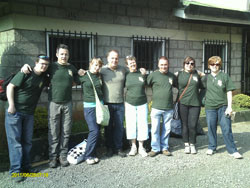 the huge Irish contingent that I had envisaged all those months ago when I had decided that I was long overdue a visit to Africa to see what I could contribute with a week of my time. What I discovered though, as the week progressed, was that what the team lacked in numbers, they more than made up for, in the love, empathy and respect they poured out to the children, teenagers and adults they encountered in Nairobi.
the huge Irish contingent that I had envisaged all those months ago when I had decided that I was long overdue a visit to Africa to see what I could contribute with a week of my time. What I discovered though, as the week progressed, was that what the team lacked in numbers, they more than made up for, in the love, empathy and respect they poured out to the children, teenagers and adults they encountered in Nairobi.
Leaving the airport and making our way along the main road back to the city provided a strange mix of sights. I was quite taken aback at the sheer numbers of people walking everywhere. That might seem a strange statement regarding a city of over 3 million people (almost equivalent to the population of Southern Ireland), but what made it seem so odd was the landscape where all these people were walking – this was a semi-rural road on the outskirts of the city – can you imagine driving from Strabane to Letterkenny and seeing people walking everywhere along the roadside, across the road, across the fields beside the road (without the hedges of course)?
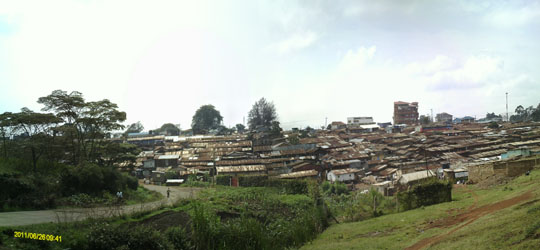
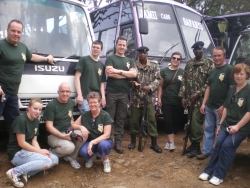 Our first item on the day’s agenda began shortly after breakfast when we got into a couple of cars and made our way over to the community police compound at the Kibera slum. In a throwback to the Bogside of the late sixties, due to a distrust of the mainstream police force, the Kiberans have their own community police station, manned by residents of the slum. Dressed in full military fatigues and beret, and carrying large rifles it soon
Our first item on the day’s agenda began shortly after breakfast when we got into a couple of cars and made our way over to the community police compound at the Kibera slum. In a throwback to the Bogside of the late sixties, due to a distrust of the mainstream police force, the Kiberans have their own community police station, manned by residents of the slum. Dressed in full military fatigues and beret, and carrying large rifles it soon  became apparent that this wasn’t going to be a group of community workers in hi-vis vests carrying walkie-talkies. In a chat I had with the Pastor who guided us around the slum, he explained that these men need to be deadly serious, as, at times the slum can erupt into very violent and sometime fatal fights. Certainly, for a Strabane man who grew up during the troubles, having an armed man in combats escorting you around, instead of eyeing you with suspicion or noting your name, address, date of birth etc, was an unusual sensation.
became apparent that this wasn’t going to be a group of community workers in hi-vis vests carrying walkie-talkies. In a chat I had with the Pastor who guided us around the slum, he explained that these men need to be deadly serious, as, at times the slum can erupt into very violent and sometime fatal fights. Certainly, for a Strabane man who grew up during the troubles, having an armed man in combats escorting you around, instead of eyeing you with suspicion or noting your name, address, date of birth etc, was an unusual sensation.
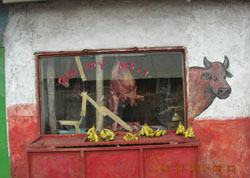 Having had no recent rain meant that
Having had no recent rain meant that 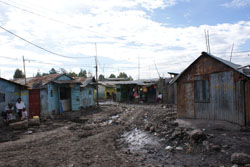 conditions underfoot (and under-nose) were considerably better than most of the information I’d seen on Kibera prior to my trip would have conveyed. However, the appalling condition of the houses and the rotting meat covered in bluebottles in the un-refrigerated butcher’s window was exactly as I’d seen on TV except this time I was faced with the stench that no documentary can ever portray!
conditions underfoot (and under-nose) were considerably better than most of the information I’d seen on Kibera prior to my trip would have conveyed. However, the appalling condition of the houses and the rotting meat covered in bluebottles in the un-refrigerated butcher’s window was exactly as I’d seen on TV except this time I was faced with the stench that no documentary can ever portray!
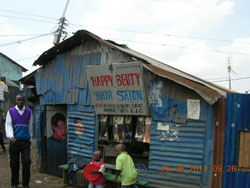 What really amazed me most were the
What really amazed me most were the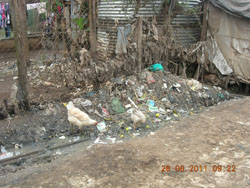 number and variety of small businesses that were operating in the slum. Yes, businesses! Amongst the filth and disarray, dotted all over the place was microeconomics at work. The Kiberans live in a situation where, if you don’t earn money, legally or illegally, morally or immorally, you starve. So when the lucky few who can get a day’s work in the city return home to the slum, they will get their bread from the local bakery at a price that they can afford out of their meagre wages. The Kenyan minimum wage is officially around £1 per day, but most of these people are so desperate they’ll work for less than that so that their family can survive.
number and variety of small businesses that were operating in the slum. Yes, businesses! Amongst the filth and disarray, dotted all over the place was microeconomics at work. The Kiberans live in a situation where, if you don’t earn money, legally or illegally, morally or immorally, you starve. So when the lucky few who can get a day’s work in the city return home to the slum, they will get their bread from the local bakery at a price that they can afford out of their meagre wages. The Kenyan minimum wage is officially around £1 per day, but most of these people are so desperate they’ll work for less than that so that their family can survive.
However, for every person in the slum who was surviving, just like any community  the world over – there were those who weren’t. The Pastor took us to visit two ladies in their homes, to see first-hand how life in Kibera really is when you’re at your most vulnerable. Both of the homes we visited were typical Kiberan shacks – a crudely constructed mix of wattle and daub walling and corrugated sheeting roofs. The interior in both cases consisted of: a bed (which took up one half of the shack); a curtain down the middle to separate the bed from the ‘living area’; and the living area, which was just a dry mud floor with a very simple coffee-table-sized table and various buckets/boxes for chairs. They were pretty much the size of your typical small garden shed/coal shed. One of the most disturbing and angering things though is that the residents have to pay rent to landlords for these shacks – most of whom are reputed to be government officers and officials!
the world over – there were those who weren’t. The Pastor took us to visit two ladies in their homes, to see first-hand how life in Kibera really is when you’re at your most vulnerable. Both of the homes we visited were typical Kiberan shacks – a crudely constructed mix of wattle and daub walling and corrugated sheeting roofs. The interior in both cases consisted of: a bed (which took up one half of the shack); a curtain down the middle to separate the bed from the ‘living area’; and the living area, which was just a dry mud floor with a very simple coffee-table-sized table and various buckets/boxes for chairs. They were pretty much the size of your typical small garden shed/coal shed. One of the most disturbing and angering things though is that the residents have to pay rent to landlords for these shacks – most of whom are reputed to be government officers and officials!
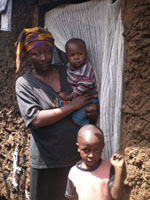 The first house was home to a mother and her
The first house was home to a mother and her 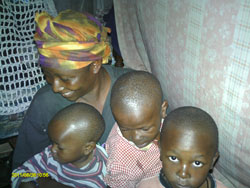 six children (one of them, her little girl aged around 9, had a disability meaning that she needed extra help and attention from her mum). The lady explained to us that her husband had ‘disappeared’ some months prior, leaving her to mind the six children whilst somehow also raising enough money to provide food for them, pay for schooling, and pay the rent for the shack. She went on to explain that she was 8 months behind with the rent for the shack and would be getting evicted soon. However, her most pressing issue was providing food for her children. She explained that they hadn’t eaten anything the previous day, and that today was shaping up to be the same for them! The sheer mix of emotions in my head at that moment was one of the most overwhelming feelings I’ve ever had in my life – thank God it was dark in there! In all of my days growing up as the child of a widow (my dad died when I was 3½ and my sister was 9 months old), we went through tough times occasionally, but never to the extent that we didn’t have three square meals a day sitting on the table for us, toys to play with, a television to watch, a warm free classroom...and a host of other things that we took for granted, that these children would describe as luxuries.
six children (one of them, her little girl aged around 9, had a disability meaning that she needed extra help and attention from her mum). The lady explained to us that her husband had ‘disappeared’ some months prior, leaving her to mind the six children whilst somehow also raising enough money to provide food for them, pay for schooling, and pay the rent for the shack. She went on to explain that she was 8 months behind with the rent for the shack and would be getting evicted soon. However, her most pressing issue was providing food for her children. She explained that they hadn’t eaten anything the previous day, and that today was shaping up to be the same for them! The sheer mix of emotions in my head at that moment was one of the most overwhelming feelings I’ve ever had in my life – thank God it was dark in there! In all of my days growing up as the child of a widow (my dad died when I was 3½ and my sister was 9 months old), we went through tough times occasionally, but never to the extent that we didn’t have three square meals a day sitting on the table for us, toys to play with, a television to watch, a warm free classroom...and a host of other things that we took for granted, that these children would describe as luxuries.
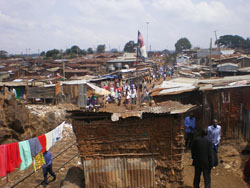 The second house that we visited was similar in proportion and make-up to the first, except that when we arrived the mum was at home alone with only her youngest child sleeping on a little bench (with no sides – can you imagine the reaction if a parent did that here?). She explained that she was also in a potential eviction situation regarding the rent arrears, however this time she openly wept as she told us of how her, now also vanished husband, had given her AIDS whilst she was pregnant with the little boy on the bench, and that she and her son now both had it and needed medication to control the symptoms. So not only had she to try to raise enough money to feed herself and her children, she also had to fund medication on top of that!
The second house that we visited was similar in proportion and make-up to the first, except that when we arrived the mum was at home alone with only her youngest child sleeping on a little bench (with no sides – can you imagine the reaction if a parent did that here?). She explained that she was also in a potential eviction situation regarding the rent arrears, however this time she openly wept as she told us of how her, now also vanished husband, had given her AIDS whilst she was pregnant with the little boy on the bench, and that she and her son now both had it and needed medication to control the symptoms. So not only had she to try to raise enough money to feed herself and her children, she also had to fund medication on top of that!
In both cases, before leaving, after we’d composed ourselves again, we joined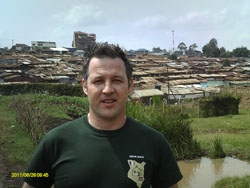 with the ladies in saying a few prayers for their plight – they both have a very strong faith that God will see them through their dire times – and everyone helped ease their money worries (for a while, anyway).
with the ladies in saying a few prayers for their plight – they both have a very strong faith that God will see them through their dire times – and everyone helped ease their money worries (for a while, anyway).
I suppose at this point I’d better thank you for taking the time to stick with this, and reading this so far! Although there were other low points to the week, meeting those ladies and hearing their plight was perhaps the lowest point of all, so grab a hankie and clean those tears and snotters, as the next bit is a lot happier!
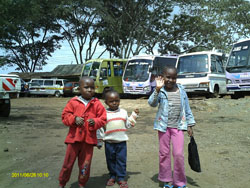 Throughout the visit to the slum we were constantly met by groups of children, who had all the most magnificent smiles and a cheerful ‘Hi’ for everyone. Not a physical possession to their name. Not a toy. But still possessing the ability to give the warmest cheeriest smile, and all repeating the same mantra when asked “How are you?” – “Fine”.
Throughout the visit to the slum we were constantly met by groups of children, who had all the most magnificent smiles and a cheerful ‘Hi’ for everyone. Not a physical possession to their name. Not a toy. But still possessing the ability to give the warmest cheeriest smile, and all repeating the same mantra when asked “How are you?” – “Fine”.
After the visit to the head-spinning mix of the dismal realities of life and contrasting demeanour of the strangely upbeat kids of Kibera, we went then set off for the site of our work for the week, the Cheryl’s Children’s Home & Learning Centre.
Cheryl’s was set up in 1999 by a local husband and wife team who had  heard of the plight of all of the kids being orphaned by AIDS and being left to fend for themselves in Kibera. Its original incarnation was a corrugated hut below the railway line that bisects the slum. However, after a flood washed the hut away, they very urgently had to reconstruct the home on higher ground, where it is located today. However, in the ensuing years several groups of Irish workers under the direction of Sligo man Basil Love, have turned the overcrowded, leaky structures into spacious, watertight concrete dormitories housing 72 orphans, and not only that, but adjacent to this they have constructed a magnificent primary school which takes in over 200 children from the slum every day, and provides them with a much sought after education, and a warm meal each lunchtime (which for some of them is the only meal of the day!).
heard of the plight of all of the kids being orphaned by AIDS and being left to fend for themselves in Kibera. Its original incarnation was a corrugated hut below the railway line that bisects the slum. However, after a flood washed the hut away, they very urgently had to reconstruct the home on higher ground, where it is located today. However, in the ensuing years several groups of Irish workers under the direction of Sligo man Basil Love, have turned the overcrowded, leaky structures into spacious, watertight concrete dormitories housing 72 orphans, and not only that, but adjacent to this they have constructed a magnificent primary school which takes in over 200 children from the slum every day, and provides them with a much sought after education, and a warm meal each lunchtime (which for some of them is the only meal of the day!).
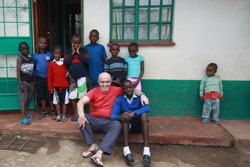 On our arrival at Cheryl’s we were greeted by
On our arrival at Cheryl’s we were greeted by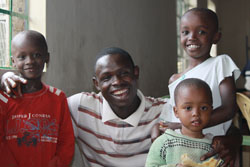 all of the staff with huge beaming smiles and the most welcoming hugs that you could imagine. They treated everyone as if they were the most special people to have stepped through the door, even though some of us, myself included, had never been there before or done anything to help them previously – such was their appreciation of any little modicum of assistance. They then brought us through to meet the children in the dining/games/recreation room. All 72 of them, young and old squeezed into the room and began singing the most beautiful floating songs and hymns, interspersed with mini speeches from some of the older kids telling how much it meant to them to be in the home and school, and how they thank God every day for what they have. It was only during various conversations later in the week that I began to unearth the poignancy of their gratefulness when I heard that whilst the majority of these children had been orphaned by AIDS, which in itself must have been horrendous, some had come from even more harrowing backgrounds. One girl had watched as her family were burned alive, barricaded in a church in Eldoret, whilst sheltering from the violence that ensued after the national election of 2008. Another was the sole survivor of a machete attack on her family during the same period. A young boy, now aged around 12, was found wandering around a bus station at age 2. No-one has been able to find his parents/grandparents or anyone who could identify him. Perhaps the most shockingly horrific rescue though, had to be the little girl that was given into her grandmother’s care when her parents died, and her own grandmother began to prostitute the child.
all of the staff with huge beaming smiles and the most welcoming hugs that you could imagine. They treated everyone as if they were the most special people to have stepped through the door, even though some of us, myself included, had never been there before or done anything to help them previously – such was their appreciation of any little modicum of assistance. They then brought us through to meet the children in the dining/games/recreation room. All 72 of them, young and old squeezed into the room and began singing the most beautiful floating songs and hymns, interspersed with mini speeches from some of the older kids telling how much it meant to them to be in the home and school, and how they thank God every day for what they have. It was only during various conversations later in the week that I began to unearth the poignancy of their gratefulness when I heard that whilst the majority of these children had been orphaned by AIDS, which in itself must have been horrendous, some had come from even more harrowing backgrounds. One girl had watched as her family were burned alive, barricaded in a church in Eldoret, whilst sheltering from the violence that ensued after the national election of 2008. Another was the sole survivor of a machete attack on her family during the same period. A young boy, now aged around 12, was found wandering around a bus station at age 2. No-one has been able to find his parents/grandparents or anyone who could identify him. Perhaps the most shockingly horrific rescue though, had to be the little girl that was given into her grandmother’s care when her parents died, and her own grandmother began to prostitute the child.
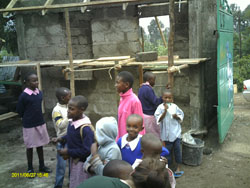 However, the whole time that I was working
However, the whole time that I was working 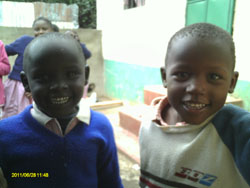 at the home, I never saw a sad face; in fact they were the most joyful, spirited children I’ve ever encountered. Every time you turned around there was a child wanting to know your name, wanting to get their photograph taken with you, asking what you were doing as you worked, and even at times, looking to give a hand!
at the home, I never saw a sad face; in fact they were the most joyful, spirited children I’ve ever encountered. Every time you turned around there was a child wanting to know your name, wanting to get their photograph taken with you, asking what you were doing as you worked, and even at times, looking to give a hand!
Mid week we had another outing planned, this time to visit “street children” at a dump-site. Travelling through the muddiest, most potholed roads I’ve ever seen (worse than anything we ever had 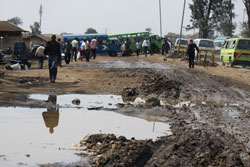 in Ireland), I really thought a few times that the car we were
in Ireland), I really thought a few times that the car we were 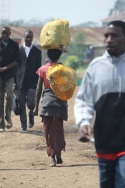 travelling in was going to disappear into one of the craters never again to re-surface. Eventually we reached another community police station (where in stark contrast to Kibera, the local policemen preferred a more Miami Vice, ‘open necked shirt and chinos’ look). From here we were guided back down more moon-cratered tracks to a site where around 30 to 40 teenagers hung around a makeshift recycling centre where they gather plastic, cans, cardboard, wood, etc to get a few shillings. The pay in most cases is much less than what is needed to get a square meal, so they resort to buying glue for sniffing, so that they can temporarily escape their living hell, albeit only mentally.
travelling in was going to disappear into one of the craters never again to re-surface. Eventually we reached another community police station (where in stark contrast to Kibera, the local policemen preferred a more Miami Vice, ‘open necked shirt and chinos’ look). From here we were guided back down more moon-cratered tracks to a site where around 30 to 40 teenagers hung around a makeshift recycling centre where they gather plastic, cans, cardboard, wood, etc to get a few shillings. The pay in most cases is much less than what is needed to get a square meal, so they resort to buying glue for sniffing, so that they can temporarily escape their living hell, albeit only mentally.
 I went over and had a chat with some of the guys,
I went over and had a chat with some of the guys, 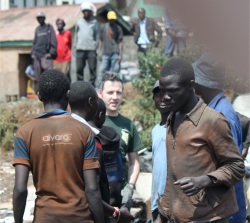 but it was quite difficult to have a normal conversation with them as they were so out of it. Ordinarily, any time I’ve met someone at a party who has been that far gone, they’re usually gas craic (if they’re still intelligible). The tone of conversation with these guys was far more ominous. When I asked about when they had eaten last, none of them were quite sure. When I asked about where they sleep at night (merely enquiring as to the type of accommodation, not the location), most suddenly didn’t answer me, but one guy looked leeringly at the policemen and said “I can’t tell you exactly where we sleep because we have to hide at night. Those same guys, who are standing over there smiling now, beat us with sticks if they see us after dark!”.
but it was quite difficult to have a normal conversation with them as they were so out of it. Ordinarily, any time I’ve met someone at a party who has been that far gone, they’re usually gas craic (if they’re still intelligible). The tone of conversation with these guys was far more ominous. When I asked about when they had eaten last, none of them were quite sure. When I asked about where they sleep at night (merely enquiring as to the type of accommodation, not the location), most suddenly didn’t answer me, but one guy looked leeringly at the policemen and said “I can’t tell you exactly where we sleep because we have to hide at night. Those same guys, who are standing over there smiling now, beat us with sticks if they see us after dark!”.
We couldn’t have left without providing them with some sustenance, so Basil  had bought a load of loaves and pouches of milk to be distributed to the group, but as one particularly coherent teenager said to me, leaving his words still ringing in my ears to this day, “These people are in desperation. What are you going to provide for them tomorrow, and the day after? When are you coming back to help these people?” I couldn’t give him an honest answer to his questions. I wonder will I ever be able to?
had bought a load of loaves and pouches of milk to be distributed to the group, but as one particularly coherent teenager said to me, leaving his words still ringing in my ears to this day, “These people are in desperation. What are you going to provide for them tomorrow, and the day after? When are you coming back to help these people?” I couldn’t give him an honest answer to his questions. I wonder will I ever be able to?
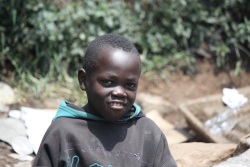 The high point to the day came quite out of the blue though, when one of the teenagers brought some of the group over to a little 8 year old sitting over at one side with blood on his jumper and quite a number of flies around him. He had been through an operation recently and part of this required a colostomy bag to be fitted. However, he had been thrown out of home some 15 miles away and had wandered around for God knows how long before being taken under the wing of the glue-sniffers. Mary Lang’at from Cheryl’s Home asked him a few questions about his condition etc, and discovered that he had been struck by
The high point to the day came quite out of the blue though, when one of the teenagers brought some of the group over to a little 8 year old sitting over at one side with blood on his jumper and quite a number of flies around him. He had been through an operation recently and part of this required a colostomy bag to be fitted. However, he had been thrown out of home some 15 miles away and had wandered around for God knows how long before being taken under the wing of the glue-sniffers. Mary Lang’at from Cheryl’s Home asked him a few questions about his condition etc, and discovered that he had been struck by 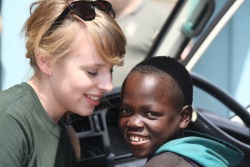 a lorry and part of his intestines was protruding from the incision in his abdomen, for the colostomy tubing. After assuring him of our good intentions and checking with the community worker and police accompanying us, it was agreed that he would be brought to hospital. On the remainder of the day’s journey he clung to the youngest member of our group, 16 year old Claire, (who then went on to fund his successful corrective surgery). He now lives at Cheryl’s home, and, within hours of arriving I saw him skipping around happily with two of the other boys as if he had always been there. As mentioned, he has had corrective surgery and has made a full recovery. He is probably the luckiest 8 year old that I know of, but who knows how many others are in his position on the streets of Nairobi?
a lorry and part of his intestines was protruding from the incision in his abdomen, for the colostomy tubing. After assuring him of our good intentions and checking with the community worker and police accompanying us, it was agreed that he would be brought to hospital. On the remainder of the day’s journey he clung to the youngest member of our group, 16 year old Claire, (who then went on to fund his successful corrective surgery). He now lives at Cheryl’s home, and, within hours of arriving I saw him skipping around happily with two of the other boys as if he had always been there. As mentioned, he has had corrective surgery and has made a full recovery. He is probably the luckiest 8 year old that I know of, but who knows how many others are in his position on the streets of Nairobi?
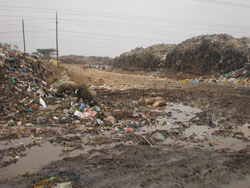 Next stop on our tour that morning was to be the municipal dump at Dandora. This is the largest dump in East Africa and serves the entire 3 million people of Nairobi. We were due to go into the dump and speak to some of the people who spend their day there searching for food or anything they can swap or trade for food, but as we approached the entrance we were advised not to go in as a large gang had gathered there and our guide felt it would be unsafe. I would have liked to have met the people, and to have spoken to them first hand like the teenagers at the previous site to try to see things from their perspective, but in the end (and unfortunately, for selfish reasons) I was glad we didn’t get to go in. I’ve been to Strabane dump when it was in full swing. I’ve spent time in a piggery in the sweltering heat of an August day, but there is nothing that could prepare you for the stench that comes from Dandora dump! However every single day, thousands of people depend on sifting through the rubbish to find something, anything to bring home a few scraps of food for their family!
Next stop on our tour that morning was to be the municipal dump at Dandora. This is the largest dump in East Africa and serves the entire 3 million people of Nairobi. We were due to go into the dump and speak to some of the people who spend their day there searching for food or anything they can swap or trade for food, but as we approached the entrance we were advised not to go in as a large gang had gathered there and our guide felt it would be unsafe. I would have liked to have met the people, and to have spoken to them first hand like the teenagers at the previous site to try to see things from their perspective, but in the end (and unfortunately, for selfish reasons) I was glad we didn’t get to go in. I’ve been to Strabane dump when it was in full swing. I’ve spent time in a piggery in the sweltering heat of an August day, but there is nothing that could prepare you for the stench that comes from Dandora dump! However every single day, thousands of people depend on sifting through the rubbish to find something, anything to bring home a few scraps of food for their family!
Our final stop that day was, gladly, a more cheerful place. We visited the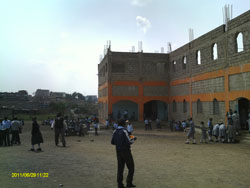 Mathare School for Street
Mathare School for Street 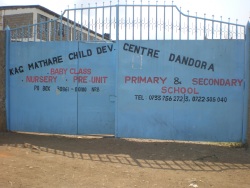 Children, which is a two site primary and secondary school that caters for over 550 children from the local slums (including Dandora – some of the children of the people searching the dump attend the schools). We arrived during the lunch break and all of the kids were out playing, so at first glance it presented a strange picture. It looked as if a couple of hundred children were playing in one of the “ghost estates” that are dotted all over Ireland. Whilst we were being brought round on a tour by the principal, she explained that the school is constantly in an unfinished state, as they are continually striving to expand the school any time they get any reasonable amount of donations gathered as demand is so immense. Just like Cheryl’s, they hope to build accommodation on-site for some of the orphaned street children over time, but at the moment the focus is on providing an education for the kids, as it is seen as the only way to break the cycle of poverty in which they have found themselves inextricably mired. Also as part of the tour we were shown the school meals kitchen that provides over 500 lunchtime meals for the children every day (and the wonderfully pleasant ladies who do all the cooking). Just like the kids who attend school at Cheryl’s, for some of them it is their only meal in the day! When asked do the government pay anything towards the quite obviously huge food bill, the principal explained that the entire food bill is met through the donations of Kenyan, American and German donors (companies, churches and individuals).
Children, which is a two site primary and secondary school that caters for over 550 children from the local slums (including Dandora – some of the children of the people searching the dump attend the schools). We arrived during the lunch break and all of the kids were out playing, so at first glance it presented a strange picture. It looked as if a couple of hundred children were playing in one of the “ghost estates” that are dotted all over Ireland. Whilst we were being brought round on a tour by the principal, she explained that the school is constantly in an unfinished state, as they are continually striving to expand the school any time they get any reasonable amount of donations gathered as demand is so immense. Just like Cheryl’s, they hope to build accommodation on-site for some of the orphaned street children over time, but at the moment the focus is on providing an education for the kids, as it is seen as the only way to break the cycle of poverty in which they have found themselves inextricably mired. Also as part of the tour we were shown the school meals kitchen that provides over 500 lunchtime meals for the children every day (and the wonderfully pleasant ladies who do all the cooking). Just like the kids who attend school at Cheryl’s, for some of them it is their only meal in the day! When asked do the government pay anything towards the quite obviously huge food bill, the principal explained that the entire food bill is met through the donations of Kenyan, American and German donors (companies, churches and individuals).
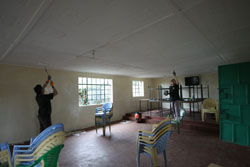 The rest of the week, apart from our morning described above, was, as expected, taken up with working at Cheryl’s
The rest of the week, apart from our morning described above, was, as expected, taken up with working at Cheryl’s  home. We were mainly put to work renovating the dining room and completing work on one of the classrooms that had been started last year. We also got to do some non-manual work too! I spent a couple of hours passing on some IT skills to three of the teenage girls who live there, to assist them with progressing on to college courses; another member of the team, John Harding, provided some of the children with careers advice – which, by all accounts, involved some considerable re-assessment of expectations – he said there were “several pilots, two neuro-surgeons, a number of doctors, an aeronautical engineer, and some lawyers”. However, the most magical skills transfer that took place that week was during the afternoon choir lessons. Led by two more members of the team - accomplished music teacher/soprano Maeve Coghlan and James D Nelson of the Celtic Tenors, who was also part of the volunteer team a group of children took time each day to learn some new songs for their already quite impressive repertoire. In 2009, the group had been trained by Maeve and James to enable them to perform at a series of concerts in Kenya to raise money for the orphanage, which they did magnificently. They were recorded during a number of their performances the following year, and a CD of this has been released to raise more funds for Cheryl’s. You could say they’re literally singing for their supper! By the way, I have copies of the CD for sale, so if you’ve been moved by this article to do something perhaps you might want to buy a couple of copies!
home. We were mainly put to work renovating the dining room and completing work on one of the classrooms that had been started last year. We also got to do some non-manual work too! I spent a couple of hours passing on some IT skills to three of the teenage girls who live there, to assist them with progressing on to college courses; another member of the team, John Harding, provided some of the children with careers advice – which, by all accounts, involved some considerable re-assessment of expectations – he said there were “several pilots, two neuro-surgeons, a number of doctors, an aeronautical engineer, and some lawyers”. However, the most magical skills transfer that took place that week was during the afternoon choir lessons. Led by two more members of the team - accomplished music teacher/soprano Maeve Coghlan and James D Nelson of the Celtic Tenors, who was also part of the volunteer team a group of children took time each day to learn some new songs for their already quite impressive repertoire. In 2009, the group had been trained by Maeve and James to enable them to perform at a series of concerts in Kenya to raise money for the orphanage, which they did magnificently. They were recorded during a number of their performances the following year, and a CD of this has been released to raise more funds for Cheryl’s. You could say they’re literally singing for their supper! By the way, I have copies of the CD for sale, so if you’ve been moved by this article to do something perhaps you might want to buy a couple of copies!
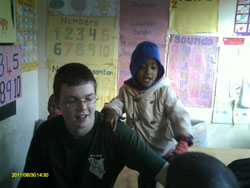 Across the hallway from the choir session
Across the hallway from the choir session 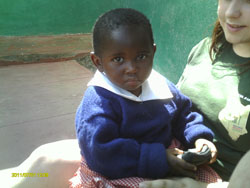 was perhaps the smallest infant classroom I’ve ever seen – a room of around 5 foot square with a couple of tables, benches and a teacher’s desk. It was here that Cian, Grace and Claire were to be found most days, helping the primary one teacher with some of the most amazingly spirited little kids ever put on this earth! And there were about fifteen of them in the room at any one time! It was in this room that they learned, ate, napped (with their head on their arm on the table) and put on the most hilarious and amazing show of “pint-sized table-top African dancing” that no pantomime could ever rival!
was perhaps the smallest infant classroom I’ve ever seen – a room of around 5 foot square with a couple of tables, benches and a teacher’s desk. It was here that Cian, Grace and Claire were to be found most days, helping the primary one teacher with some of the most amazingly spirited little kids ever put on this earth! And there were about fifteen of them in the room at any one time! It was in this room that they learned, ate, napped (with their head on their arm on the table) and put on the most hilarious and amazing show of “pint-sized table-top African dancing” that no pantomime could ever rival!
Unfortunately all good things must come to 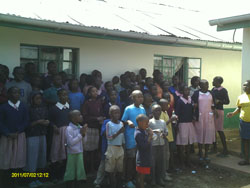 an end, and so on the Saturday afternoon we prepared to wind down operations and grab a few souvenirs at the Maasai market in preparation for the long trek home early the next morning. Obviously I knew there were going to be some painful goodbyes to be said at some point in the day, but I was completely taken aback at the way in which the staff and kids chose to send us off. As we were putting the finishing touches to the last job of the day, there was a sudden influx of kids into the yard beside us and they began to line up – row upon row of smiling faces, bursting with
an end, and so on the Saturday afternoon we prepared to wind down operations and grab a few souvenirs at the Maasai market in preparation for the long trek home early the next morning. Obviously I knew there were going to be some painful goodbyes to be said at some point in the day, but I was completely taken aback at the way in which the staff and kids chose to send us off. As we were putting the finishing touches to the last job of the day, there was a sudden influx of kids into the yard beside us and they began to line up – row upon row of smiling faces, bursting with 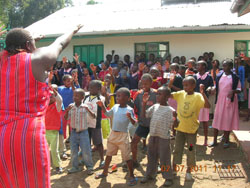 anticipation! We were then all summoned to come up to the yard where they all began to sing their hearts out with the most beautiful songs. This was followed by a very eloquent and inspiring speech by the “granddaddy” of Cheryl’s – Samuel, who explained what it meant to the kids at Cheryl’s for us to come there and give a little time, energy and love, and how the care and nurturing provided by those at the home and school had allowed them to
anticipation! We were then all summoned to come up to the yard where they all began to sing their hearts out with the most beautiful songs. This was followed by a very eloquent and inspiring speech by the “granddaddy” of Cheryl’s – Samuel, who explained what it meant to the kids at Cheryl’s for us to come there and give a little time, energy and love, and how the care and nurturing provided by those at the home and school had allowed them to 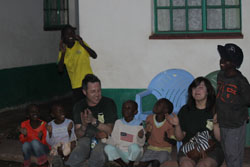 grow up experiencing things that normal kids should ordinarily experience but which they most likely would not have, had they still been in their previous life situations. Finally the kids began to sing again and the office door opened. There wasn’t a dry eye in the place as little Handerson, Grace’s sponsor child came out with a gift for her, followed by Malik with a gift for Claire, then in turn a child came out to each of us bringing a beautiful traditional hand carved Maasai mask. It was an extremely moving end to an extremely moving week.
grow up experiencing things that normal kids should ordinarily experience but which they most likely would not have, had they still been in their previous life situations. Finally the kids began to sing again and the office door opened. There wasn’t a dry eye in the place as little Handerson, Grace’s sponsor child came out with a gift for her, followed by Malik with a gift for Claire, then in turn a child came out to each of us bringing a beautiful traditional hand carved Maasai mask. It was an extremely moving end to an extremely moving week.
If you feel after reading this that you’d like to help out in any way, be through volunteering some of your time to go to Kenya and work, or by donating to Kenyabuild to help their work, or maybe you’d like to sponsor one of the children in Cheryl’s home (€35 per month to feed and keep them) then you can do so by contacting Basil Love through www.kenyabuild.com or give me a shout and I’ll give you any information you need.
 the huge Irish contingent that I had envisaged all those months ago when I had decided that I was long overdue a visit to Africa to see what I could contribute with a week of my time. What I discovered though, as the week progressed, was that what the team lacked in numbers, they more than made up for, in the love, empathy and respect they poured out to the children, teenagers and adults they encountered in Nairobi.
the huge Irish contingent that I had envisaged all those months ago when I had decided that I was long overdue a visit to Africa to see what I could contribute with a week of my time. What I discovered though, as the week progressed, was that what the team lacked in numbers, they more than made up for, in the love, empathy and respect they poured out to the children, teenagers and adults they encountered in Nairobi.
 became apparent that this wasn’t going to be a group of community workers in hi-vis vests carrying walkie-talkies. In a chat I had with the Pastor who guided us around the slum, he explained that these men need to be deadly serious, as, at times the slum can erupt into very violent and sometime fatal fights. Certainly, for a Strabane man who grew up during the troubles, having an armed man in combats escorting you around, instead of eyeing you with suspicion or noting your name, address, date of birth etc, was an unusual sensation.
became apparent that this wasn’t going to be a group of community workers in hi-vis vests carrying walkie-talkies. In a chat I had with the Pastor who guided us around the slum, he explained that these men need to be deadly serious, as, at times the slum can erupt into very violent and sometime fatal fights. Certainly, for a Strabane man who grew up during the troubles, having an armed man in combats escorting you around, instead of eyeing you with suspicion or noting your name, address, date of birth etc, was an unusual sensation. Having had no recent rain meant that
Having had no recent rain meant that  conditions underfoot (and under-nose) were considerably better than most of the information I’d seen on Kibera prior to my trip would have conveyed. However, the appalling condition of the houses and the rotting meat covered in bluebottles in the un-refrigerated butcher’s window was exactly as I’d seen on TV except this time I was faced with the stench that no documentary can ever portray!
conditions underfoot (and under-nose) were considerably better than most of the information I’d seen on Kibera prior to my trip would have conveyed. However, the appalling condition of the houses and the rotting meat covered in bluebottles in the un-refrigerated butcher’s window was exactly as I’d seen on TV except this time I was faced with the stench that no documentary can ever portray! What really amazed me most were the
What really amazed me most were the number and variety of small businesses that were operating in the slum. Yes, businesses! Amongst the filth and disarray, dotted all over the place was microeconomics at work. The Kiberans live in a situation where, if you don’t earn money, legally or illegally, morally or immorally, you starve. So when the lucky few who can get a day’s work in the city return home to the slum, they will get their bread from the local bakery at a price that they can afford out of their meagre wages. The Kenyan minimum wage is officially around £1 per day, but most of these people are so desperate they’ll work for less than that so that their family can survive.
number and variety of small businesses that were operating in the slum. Yes, businesses! Amongst the filth and disarray, dotted all over the place was microeconomics at work. The Kiberans live in a situation where, if you don’t earn money, legally or illegally, morally or immorally, you starve. So when the lucky few who can get a day’s work in the city return home to the slum, they will get their bread from the local bakery at a price that they can afford out of their meagre wages. The Kenyan minimum wage is officially around £1 per day, but most of these people are so desperate they’ll work for less than that so that their family can survive. the world over – there were those who weren’t. The Pastor took us to visit two ladies in their homes, to see first-hand how life in Kibera really is when you’re at your most vulnerable. Both of the homes we visited were typical Kiberan shacks – a crudely constructed mix of wattle and daub walling and corrugated sheeting roofs. The interior in both cases consisted of: a bed (which took up one half of the shack); a curtain down the middle to separate the bed from the ‘living area’; and the living area, which was just a dry mud floor with a very simple coffee-table-sized table and various buckets/boxes for chairs. They were pretty much the size of your typical small garden shed/coal shed. One of the most disturbing and angering things though is that the residents have to pay rent to landlords for these shacks – most of whom are reputed to be government officers and officials!
the world over – there were those who weren’t. The Pastor took us to visit two ladies in their homes, to see first-hand how life in Kibera really is when you’re at your most vulnerable. Both of the homes we visited were typical Kiberan shacks – a crudely constructed mix of wattle and daub walling and corrugated sheeting roofs. The interior in both cases consisted of: a bed (which took up one half of the shack); a curtain down the middle to separate the bed from the ‘living area’; and the living area, which was just a dry mud floor with a very simple coffee-table-sized table and various buckets/boxes for chairs. They were pretty much the size of your typical small garden shed/coal shed. One of the most disturbing and angering things though is that the residents have to pay rent to landlords for these shacks – most of whom are reputed to be government officers and officials! The first house was home to a mother and her
The first house was home to a mother and her  six children (one of them, her little girl aged around 9, had a disability meaning that she needed extra help and attention from her mum). The lady explained to us that her husband had ‘disappeared’ some months prior, leaving her to mind the six children whilst somehow also raising enough money to provide food for them, pay for schooling, and pay the rent for the shack. She went on to explain that she was 8 months behind with the rent for the shack and would be getting evicted soon. However, her most pressing issue was providing food for her children. She explained that they hadn’t eaten anything the previous day, and that today was shaping up to be the same for them! The sheer mix of emotions in my head at that moment was one of the most overwhelming feelings I’ve ever had in my life – thank God it was dark in there! In all of my days growing up as the child of a widow (my dad died when I was 3½ and my sister was 9 months old), we went through tough times occasionally, but never to the extent that we didn’t have three square meals a day sitting on the table for us, toys to play with, a television to watch, a warm free classroom...and a host of other things that we took for granted, that these children would describe as luxuries.
six children (one of them, her little girl aged around 9, had a disability meaning that she needed extra help and attention from her mum). The lady explained to us that her husband had ‘disappeared’ some months prior, leaving her to mind the six children whilst somehow also raising enough money to provide food for them, pay for schooling, and pay the rent for the shack. She went on to explain that she was 8 months behind with the rent for the shack and would be getting evicted soon. However, her most pressing issue was providing food for her children. She explained that they hadn’t eaten anything the previous day, and that today was shaping up to be the same for them! The sheer mix of emotions in my head at that moment was one of the most overwhelming feelings I’ve ever had in my life – thank God it was dark in there! In all of my days growing up as the child of a widow (my dad died when I was 3½ and my sister was 9 months old), we went through tough times occasionally, but never to the extent that we didn’t have three square meals a day sitting on the table for us, toys to play with, a television to watch, a warm free classroom...and a host of other things that we took for granted, that these children would describe as luxuries. The second house that we visited was similar in proportion and make-up to the first, except that when we arrived the mum was at home alone with only her youngest child sleeping on a little bench (with no sides – can you imagine the reaction if a parent did that here?). She explained that she was also in a potential eviction situation regarding the rent arrears, however this time she openly wept as she told us of how her, now also vanished husband, had given her AIDS whilst she was pregnant with the little boy on the bench, and that she and her son now both had it and needed medication to control the symptoms. So not only had she to try to raise enough money to feed herself and her children, she also had to fund medication on top of that!
The second house that we visited was similar in proportion and make-up to the first, except that when we arrived the mum was at home alone with only her youngest child sleeping on a little bench (with no sides – can you imagine the reaction if a parent did that here?). She explained that she was also in a potential eviction situation regarding the rent arrears, however this time she openly wept as she told us of how her, now also vanished husband, had given her AIDS whilst she was pregnant with the little boy on the bench, and that she and her son now both had it and needed medication to control the symptoms. So not only had she to try to raise enough money to feed herself and her children, she also had to fund medication on top of that! with the ladies in saying a few prayers for their plight – they both have a very strong faith that God will see them through their dire times – and everyone helped ease their money worries (for a while, anyway).
with the ladies in saying a few prayers for their plight – they both have a very strong faith that God will see them through their dire times – and everyone helped ease their money worries (for a while, anyway).  Throughout the visit to the slum we were constantly met by groups of children, who had all the most magnificent smiles and a cheerful ‘Hi’ for everyone. Not a physical possession to their name. Not a toy. But still possessing the ability to give the warmest cheeriest smile, and all repeating the same mantra when asked “How are you?” – “Fine”.
Throughout the visit to the slum we were constantly met by groups of children, who had all the most magnificent smiles and a cheerful ‘Hi’ for everyone. Not a physical possession to their name. Not a toy. But still possessing the ability to give the warmest cheeriest smile, and all repeating the same mantra when asked “How are you?” – “Fine”. heard of the plight of all of the kids being orphaned by AIDS and being left to fend for themselves in Kibera. Its original incarnation was a corrugated hut below the railway line that bisects the slum. However, after a flood washed the hut away, they very urgently had to reconstruct the home on higher ground, where it is located today. However, in the ensuing years several groups of Irish workers under the direction of Sligo man Basil Love, have turned the overcrowded, leaky structures into spacious, watertight concrete dormitories housing 72 orphans, and not only that, but adjacent to this they have constructed a magnificent primary school which takes in over 200 children from the slum every day, and provides them with a much sought after education, and a warm meal each lunchtime (which for some of them is the only meal of the day!).
heard of the plight of all of the kids being orphaned by AIDS and being left to fend for themselves in Kibera. Its original incarnation was a corrugated hut below the railway line that bisects the slum. However, after a flood washed the hut away, they very urgently had to reconstruct the home on higher ground, where it is located today. However, in the ensuing years several groups of Irish workers under the direction of Sligo man Basil Love, have turned the overcrowded, leaky structures into spacious, watertight concrete dormitories housing 72 orphans, and not only that, but adjacent to this they have constructed a magnificent primary school which takes in over 200 children from the slum every day, and provides them with a much sought after education, and a warm meal each lunchtime (which for some of them is the only meal of the day!). On our arrival at Cheryl’s we were greeted by
On our arrival at Cheryl’s we were greeted by all of the staff with huge beaming smiles and the most welcoming hugs that you could imagine. They treated everyone as if they were the most special people to have stepped through the door, even though some of us, myself included, had never been there before or done anything to help them previously – such was their appreciation of any little modicum of assistance. They then brought us through to meet the children in the dining/games/recreation room. All 72 of them, young and old squeezed into the room and began singing the most beautiful floating songs and hymns, interspersed with mini speeches from some of the older kids telling how much it meant to them to be in the home and school, and how they thank God every day for what they have. It was only during various conversations later in the week that I began to unearth the poignancy of their gratefulness when I heard that whilst the majority of these children had been orphaned by AIDS, which in itself must have been horrendous, some had come from even more harrowing backgrounds. One girl had watched as her family were burned alive, barricaded in a church in
all of the staff with huge beaming smiles and the most welcoming hugs that you could imagine. They treated everyone as if they were the most special people to have stepped through the door, even though some of us, myself included, had never been there before or done anything to help them previously – such was their appreciation of any little modicum of assistance. They then brought us through to meet the children in the dining/games/recreation room. All 72 of them, young and old squeezed into the room and began singing the most beautiful floating songs and hymns, interspersed with mini speeches from some of the older kids telling how much it meant to them to be in the home and school, and how they thank God every day for what they have. It was only during various conversations later in the week that I began to unearth the poignancy of their gratefulness when I heard that whilst the majority of these children had been orphaned by AIDS, which in itself must have been horrendous, some had come from even more harrowing backgrounds. One girl had watched as her family were burned alive, barricaded in a church in  However, the whole time that I was working
However, the whole time that I was working  at the home, I never saw a sad face; in fact they were the most joyful, spirited children I’ve ever encountered. Every time you turned around there was a child wanting to know your name, wanting to get their photograph taken with you, asking what you were doing as you worked, and even at times, looking to give a hand!
at the home, I never saw a sad face; in fact they were the most joyful, spirited children I’ve ever encountered. Every time you turned around there was a child wanting to know your name, wanting to get their photograph taken with you, asking what you were doing as you worked, and even at times, looking to give a hand!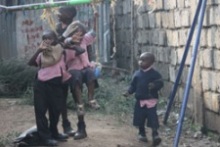
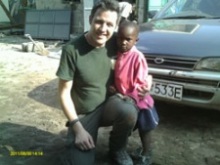
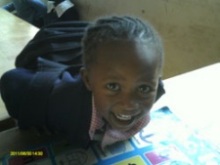
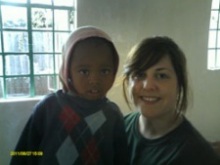
 in Ireland), I really thought a few times that the car we were
in Ireland), I really thought a few times that the car we were  travelling in was going to disappear into one of the craters never again to re-surface. Eventually we reached another community police station (where in stark contrast to Kibera, the local policemen preferred a more Miami Vice, ‘open necked shirt and chinos’ look). From here we were guided back down more moon-cratered tracks to a site where around 30 to 40 teenagers hung around a makeshift recycling centre where they gather plastic, cans, cardboard, wood, etc to get a few shillings. The pay in most cases is much less than what is needed to get a square meal, so they resort to buying glue for sniffing, so that they can temporarily escape their living hell, albeit only mentally.
travelling in was going to disappear into one of the craters never again to re-surface. Eventually we reached another community police station (where in stark contrast to Kibera, the local policemen preferred a more Miami Vice, ‘open necked shirt and chinos’ look). From here we were guided back down more moon-cratered tracks to a site where around 30 to 40 teenagers hung around a makeshift recycling centre where they gather plastic, cans, cardboard, wood, etc to get a few shillings. The pay in most cases is much less than what is needed to get a square meal, so they resort to buying glue for sniffing, so that they can temporarily escape their living hell, albeit only mentally.  I went over and had a chat with some of the guys,
I went over and had a chat with some of the guys,  had bought a load of loaves and pouches of milk to be distributed to the group, but as one particularly coherent teenager said to me, leaving his words still ringing in my ears to this day, “These people are in desperation. What are you going to provide for them tomorrow, and the day after? When are you coming back to help these people?” I couldn’t give him an honest answer to his questions. I wonder will I ever be able to?
had bought a load of loaves and pouches of milk to be distributed to the group, but as one particularly coherent teenager said to me, leaving his words still ringing in my ears to this day, “These people are in desperation. What are you going to provide for them tomorrow, and the day after? When are you coming back to help these people?” I couldn’t give him an honest answer to his questions. I wonder will I ever be able to? The high point to the day came quite out of the blue though, when one of the teenagers brought some of the group over to a little 8 year old sitting over at one side with blood on his jumper and quite a number of flies around him. He had been through an operation recently and part of this required a colostomy bag to be fitted. However, he had been thrown out of home some 15 miles away and had wandered around for God knows how long before being taken under the wing of the glue-sniffers. Mary Lang’at from Cheryl’s Home asked him a few questions about his condition etc, and discovered that he had been struck by
The high point to the day came quite out of the blue though, when one of the teenagers brought some of the group over to a little 8 year old sitting over at one side with blood on his jumper and quite a number of flies around him. He had been through an operation recently and part of this required a colostomy bag to be fitted. However, he had been thrown out of home some 15 miles away and had wandered around for God knows how long before being taken under the wing of the glue-sniffers. Mary Lang’at from Cheryl’s Home asked him a few questions about his condition etc, and discovered that he had been struck by  a lorry and part of his intestines was protruding from the incision in his abdomen, for the colostomy tubing. After assuring him of our good intentions and checking with the community worker and police accompanying us, it was agreed that he would be brought to hospital. On the remainder of the day’s journey he clung to the youngest member of our group, 16 year old Claire, (who then went on to fund his successful corrective surgery). He now lives at Cheryl’s home, and, within hours of arriving I saw him skipping around happily with two of the other boys as if he had always been there. As mentioned, he has had corrective surgery and has made a full recovery. He is probably the luckiest 8 year old that I know of, but who knows how many others are in his position on the streets of Nairobi?
a lorry and part of his intestines was protruding from the incision in his abdomen, for the colostomy tubing. After assuring him of our good intentions and checking with the community worker and police accompanying us, it was agreed that he would be brought to hospital. On the remainder of the day’s journey he clung to the youngest member of our group, 16 year old Claire, (who then went on to fund his successful corrective surgery). He now lives at Cheryl’s home, and, within hours of arriving I saw him skipping around happily with two of the other boys as if he had always been there. As mentioned, he has had corrective surgery and has made a full recovery. He is probably the luckiest 8 year old that I know of, but who knows how many others are in his position on the streets of Nairobi? Next stop on our tour that morning was to be the municipal dump at Dandora. This is the largest dump in East Africa and serves the entire 3 million people of Nairobi. We were due to go into the dump and speak to some of the people who spend their day there searching for food or anything they can swap or trade for food, but as we approached the entrance we were advised not to go in as a large gang had gathered there and our guide felt it would be unsafe. I would have liked to have met the people, and to have spoken to them first hand like the teenagers at the previous site to try to see things from their perspective, but in the end (and unfortunately, for selfish reasons) I was glad we didn’t get to go in. I’ve been to Strabane dump when it was in full swing. I’ve spent time in a piggery in the sweltering heat of an August day, but there is nothing that could prepare you for the stench that comes from Dandora dump! However every single day, thousands of people depend on sifting through the rubbish to find something, anything to bring home a few scraps of food for their family!
Next stop on our tour that morning was to be the municipal dump at Dandora. This is the largest dump in East Africa and serves the entire 3 million people of Nairobi. We were due to go into the dump and speak to some of the people who spend their day there searching for food or anything they can swap or trade for food, but as we approached the entrance we were advised not to go in as a large gang had gathered there and our guide felt it would be unsafe. I would have liked to have met the people, and to have spoken to them first hand like the teenagers at the previous site to try to see things from their perspective, but in the end (and unfortunately, for selfish reasons) I was glad we didn’t get to go in. I’ve been to Strabane dump when it was in full swing. I’ve spent time in a piggery in the sweltering heat of an August day, but there is nothing that could prepare you for the stench that comes from Dandora dump! However every single day, thousands of people depend on sifting through the rubbish to find something, anything to bring home a few scraps of food for their family! Mathare School for Street
Mathare School for Street  The rest of the week, apart from our morning described above, was, as expected, taken up with working at Cheryl’s
The rest of the week, apart from our morning described above, was, as expected, taken up with working at Cheryl’s  home. We were mainly put to work renovating the dining room and completing work on one of the classrooms that had been started last year. We also got to do some non-manual work too! I spent a couple of hours passing on some IT skills to three of the teenage girls who live there, to assist them with progressing on to college courses; another member of the team, John Harding, provided some of the children with careers advice – which, by all accounts, involved some considerable re-assessment of expectations – he said there were “several pilots, two neuro-surgeons, a number of doctors, an aeronautical engineer, and some lawyers”. However, the most magical skills transfer that took place that week was during the afternoon choir lessons. Led by two more members of the team - accomplished music teacher/soprano Maeve Coghlan and James D Nelson of the Celtic Tenors, who was also part of the volunteer team a group of children took time each day to learn some new songs for their already quite impressive repertoire. In 2009, the group had been trained by Maeve and James to enable them to perform at a series of concerts in Kenya to raise money for the orphanage, which they did magnificently. They were recorded during a number of their performances the following year, and a CD of this has been released to raise more funds for Cheryl’s. You could say they’re literally singing for their supper! By the way, I have copies of the CD for sale, so if you’ve been moved by this article to do something perhaps you might want to buy a couple of copies!
home. We were mainly put to work renovating the dining room and completing work on one of the classrooms that had been started last year. We also got to do some non-manual work too! I spent a couple of hours passing on some IT skills to three of the teenage girls who live there, to assist them with progressing on to college courses; another member of the team, John Harding, provided some of the children with careers advice – which, by all accounts, involved some considerable re-assessment of expectations – he said there were “several pilots, two neuro-surgeons, a number of doctors, an aeronautical engineer, and some lawyers”. However, the most magical skills transfer that took place that week was during the afternoon choir lessons. Led by two more members of the team - accomplished music teacher/soprano Maeve Coghlan and James D Nelson of the Celtic Tenors, who was also part of the volunteer team a group of children took time each day to learn some new songs for their already quite impressive repertoire. In 2009, the group had been trained by Maeve and James to enable them to perform at a series of concerts in Kenya to raise money for the orphanage, which they did magnificently. They were recorded during a number of their performances the following year, and a CD of this has been released to raise more funds for Cheryl’s. You could say they’re literally singing for their supper! By the way, I have copies of the CD for sale, so if you’ve been moved by this article to do something perhaps you might want to buy a couple of copies! Across the hallway from the choir session
Across the hallway from the choir session  was perhaps the smallest infant classroom I’ve ever seen – a room of around 5 foot square with a couple of tables, benches and a teacher’s desk. It was here that Cian, Grace and Claire were to be found most days, helping the primary one teacher with some of the most amazingly spirited little kids ever put on this earth! And there were about fifteen of them in the room at any one time! It was in this room that they learned, ate, napped (with their head on their arm on the table) and put on the most hilarious and amazing show of “pint-sized table-top African dancing” that no pantomime could ever rival!
was perhaps the smallest infant classroom I’ve ever seen – a room of around 5 foot square with a couple of tables, benches and a teacher’s desk. It was here that Cian, Grace and Claire were to be found most days, helping the primary one teacher with some of the most amazingly spirited little kids ever put on this earth! And there were about fifteen of them in the room at any one time! It was in this room that they learned, ate, napped (with their head on their arm on the table) and put on the most hilarious and amazing show of “pint-sized table-top African dancing” that no pantomime could ever rival! an end, and so on the Saturday afternoon we prepared to wind down operations and grab a few souvenirs at the Maasai market in preparation for the long trek home early the next morning. Obviously I knew there were going to be some painful goodbyes to be said at some point in the day, but I was completely taken aback at the way in which the staff and kids chose to send us off. As we were putting the finishing touches to the last job of the day, there was a sudden influx of kids into the yard beside us and they began to line up – row upon row of smiling faces, bursting with
an end, and so on the Saturday afternoon we prepared to wind down operations and grab a few souvenirs at the Maasai market in preparation for the long trek home early the next morning. Obviously I knew there were going to be some painful goodbyes to be said at some point in the day, but I was completely taken aback at the way in which the staff and kids chose to send us off. As we were putting the finishing touches to the last job of the day, there was a sudden influx of kids into the yard beside us and they began to line up – row upon row of smiling faces, bursting with  anticipation! We were then all summoned to come up to the yard where they all began to sing their hearts out with the most beautiful songs. This was followed by a very eloquent and inspiring speech by the “granddaddy” of Cheryl’s – Samuel, who explained what it meant to the kids at Cheryl’s for us to come there and give a little time, energy and love, and how the care and nurturing provided by those at the home and school had allowed them to
anticipation! We were then all summoned to come up to the yard where they all began to sing their hearts out with the most beautiful songs. This was followed by a very eloquent and inspiring speech by the “granddaddy” of Cheryl’s – Samuel, who explained what it meant to the kids at Cheryl’s for us to come there and give a little time, energy and love, and how the care and nurturing provided by those at the home and school had allowed them to  grow up experiencing things that normal kids should ordinarily experience but which they most likely would not have, had they still been in their previous life situations. Finally the kids began to sing again and the office door opened. There wasn’t a dry eye in the place as little Handerson, Grace’s sponsor child came out with a gift for her, followed by Malik with a gift for Claire, then in turn a child came out to each of us bringing a beautiful traditional hand carved Maasai mask. It was an extremely moving end to an extremely moving week.
grow up experiencing things that normal kids should ordinarily experience but which they most likely would not have, had they still been in their previous life situations. Finally the kids began to sing again and the office door opened. There wasn’t a dry eye in the place as little Handerson, Grace’s sponsor child came out with a gift for her, followed by Malik with a gift for Claire, then in turn a child came out to each of us bringing a beautiful traditional hand carved Maasai mask. It was an extremely moving end to an extremely moving week.